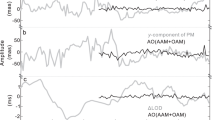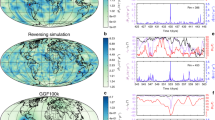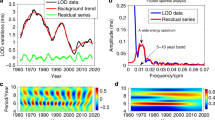Abstract
Differential rotation of Earth’s inner core relative to the mantle is thought to occur under the effects of the geodynamo on core dynamics and gravitational core–mantle coupling. This rotation has been inferred from temporal changes between repeated seismic waves that should traverse the same path through the inner core. Here we analyse repeated seismic waves from the early 1990s and show that all of the paths that previously showed significant temporal changes have exhibited little change over the past decade. This globally consistent pattern suggests that differential inner-core rotation has recently paused. We compared this recent pattern to the Alaskan seismic records of South Sandwich Islands doublets going back to 1964 and it seems to be associated with a gradual turning-back of the inner core relative to the mantle as a part of an approximately seven-decade oscillation, with another turning point in the early 1970s. This multidecadal periodicity coincides with changes in several other geophysical observations, especially the length of day and magnetic field. These observations provide evidence for dynamic interactions between the Earth’s layers, from the deepest interior to the surface, potentially due to gravitational coupling and the exchange of angular momentum from the core and mantle to the surface.
This is a preview of subscription content, access via your institution
Access options
Access Nature and 54 other Nature Portfolio journals
Get Nature+, our best-value online-access subscription
$29.99 / 30 days
cancel any time
Subscribe to this journal
Receive 12 print issues and online access
$259.00 per year
only $21.58 per issue
Buy this article
- Purchase on Springer Link
- Instant access to full article PDF
Prices may be subject to local taxes which are calculated during checkout




Similar content being viewed by others
Data availability
The digital waveform data in this study are openly available from the Incorporated Research Institutions for Seismology Data Management Center (http://iris.edu) and Canadian National Seismograph Network (http://earthquakescanada.nrcan.gc.ca/stndon/CNSN-RNSC/index-en.php). The analogue waveforms from the station COL were collected and manually digitized by ref. 7, and those of the SSI doublets are available at https://doi.org/10.6084/m9.figshare.21548679.v1. The yearly averaged LOD measurements and the daily Earth Orientation Parameters series (EOPC04) are freely downloaded from the International Earth Rotation and Reference Systems (https://www.iers.org/IERS/EN/Home/home_node.html).
Code availability
The codes used in this study are available upon request.
Change history
31 January 2023
A Correction to this paper has been published: https://doi.org/10.1038/s41561-023-01136-z
References
Buffett, B. A. Earth’s core and the geodynamo. Science 288, 2007–2012 (2000).
Gubbins, D. Rotation of the inner core. J. Geophys. Res. Solid Earth 86, 11695–11699 (1981).
Glatzmaier, G. A. & Roberts, P. H. A three-dimensional convective dynamo solution with rotating and finitely conducting inner core and mantle. Phys. Earth Planet. Inter. 91, 63–75 (1995).
Glatzmaier, G. A. & Roberts, P. H. Rotation and magnetism of Earth’s inner core. Science 274, 1887–1891 (1996).
Vidale, J. E. & Earle, P. S. Fine-scale heterogeneity in the Earth’s inner core. Nature 404, 273–275 (2000).
Creager, K. C. Inner core rotation rate from small-scale heterogeneity and time-varying travel times. Science 278, 1284–1288 (1997).
Song, X. Joint inversion for inner core rotation, inner core anisotropy, and mantle heterogeneity. J. Geophys. Res. Solid Earth 105, 7931–7943 (2000).
Attanayake, J., Thomas, C., Cormier, V. F., Miller, M. S. & Koper, K. D. Irregular transition layer beneath the earth’s inner core boundary from observations of antipodal PKIKP and PKIIKP waves. Geochem. Geophys. Geosyst. 19, 3607–3622 (2018).
Tanaka, S. & Hamaguchi, H. Degree one heterogeneity and hemispherical variation of anisotropy in the inner core from PKP(BC)–PKP(DF) times. J. Geophys. Res. Solid Earth 102, 2925–2938 (1997).
Niu, F. & Wen, L. Hemispherical variations in seismic velocity at the top of the Earth’s inner core. Nature 410, 1081–1084 (2001).
Sun, X. & Song, X. Tomographic inversion for three-dimensional anisotropy of Earth’s inner core. Phys. Earth Planet. Inter. 167, 53–70 (2008).
Buffett, B. A. Gravitational oscillations in the length of day. Geophys. Res. Lett. 23, 2279–2282 (1996).
Buffett, B. A. & Creager, K. C. A comparison of geodetic and seismic estimates of inner-core rotation. Geophys. Res. Lett. 26, 1509–1512 (1999).
Buffett, B. A. & Glatzmaier, G. A. Gravitational braking of inner-core rotation in geodynamo simulations. Geophys. Res. Lett. 27, 3125–3128 (2000).
Aurnou, J. & Olson, P. Control of inner core rotation by electromagnetic, gravitational and mechanical torques. Phys. Earth Planet. Inter. 117, 111–121 (2000).
Davies, C. J., Stegman, D. R. & Dumberry, M. The strength of gravitational core–mantle coupling. Geophys. Res. Lett. 41, 3786–3792 (2014).
Song, X. & Richards, P. G. Seismological evidence for differential rotation of the Earth’s inner core. Nature 382, 221–224 (1996).
Vidale, J. E., Dodge, D. A. & Earle, P. S. Slow differential rotation of the Earth’s inner core indicated by temporal changes in scattering. Nature 405, 445–448 (2000).
Zhang, J. et al. Inner core differential motion confirmed by earthquake waveform doublets. Science 309, 1357–1360 (2005).
Yang, Y. & Song, X. Temporal changes of the inner core from globally distributed repeating earthquakes. J. Geophys. Res. Solid Earth 125, e2019JB018652 (2020).
Poupinet, G., Ellsworth, W. L. & Frechet, J. Monitoring velocity variations in the crust using earthquake doublets: an application to the Calaveras Fault, California. J. Geophys. Res. Solid Earth 89, 5719–5731 (1984).
Wen, L. Localized temporal change of the Earth’s inner core boundary. Science 314, 967–970 (2006).
Yao, J., Tian, D., Sun, L. & Wen, L. Temporal change of seismic Earth’s inner core phases: inner core differential rotation or temporal change of inner core surface? J. Geophys. Res. Solid Earth 124, 6720–6736 (2019).
Yao, J., Tian, D., Sun, L. & Wen, L. Comment on “Origin of temporal changes of inner-core seismic waves” by Yang and Song (2020). Earth Planet. Sci. Lett. 553, 116640 (2021).
Yang, Y. & Song, X. Origin of temporal changes of inner-core seismic waves. Earth Planet. Sci. Lett. 541, 116267 (2020).
Yang, Y. & Song, X. Reply to Yao et al.’s comment on “Origin of temporal changes of inner-core seismic waves”. Earth Planet. Sci. Lett. 553, 116639 (2021).
Wang, W. & Vidale, J. E. Earth’s inner core rotation, 1971 to 1974, illuminated by inner-core scattered waves. Earth Planet. Sci. Lett. 577, 117214 (2022).
Zhang, J., Richards, P. G. & Schaff, D. P. Wide-scale detection of earthquake waveform doublets and further evidence for inner core super-rotation. Geophys. J. Int. 174, 993–1006 (2008).
Cao, A., Masson, Y. & Romanowicz, B. Short wavelength topography on the inner-core boundary. Proc. Natl Acad. Sci. USA 104, 31–35 (2007).
Song, X. & Dai, W. Topography of Earth’s inner core boundary from high-quality waveform doublets. Geophys. J. Int. 175, 386–399 (2008).
Yao, J., Sun, L. & Wen, L. Two decades of temporal change of Earth’s inner core boundary. J. Geophys. Res. Solid Earth 120, 6263–6283 (2015).
Efron, B. & Tibshirani, R. J. An Introduction to the Bootstrap (Chapman and Hall/CRC, 1994).
Tkalčić, H., Young, M., Bodin, T., Ngo, S. & Sambridge, M. The shuffling rotation of the Earth’s inner core revealed by earthquake doublets. Nat. Geosci. 6, 497–502 (2013).
Wang, W. & Vidale, J. E. Seismological observation of Earth’s oscillating inner core. Sci. Adv. 8, eabm9916 (2022).
Yang, Y. & Song, X. Inner core rotation captured by earthquake doublets and twin stations. Geophys. Res. Lett. 49, e2022GL098393 (2022).
Braginsky, S. I. Torsional magnetohydrodynamic vibrations in the Earth’s core and variations in day length. Geomagn. Aeron. 10, 1–8 (1970).
Roberts, P. H., Yu, Z. J. & Russell, C. T. On the 60-year signal from the core. Geophys. Astrophys. Fluid Dyn. 101, 11–35 (2007).
Hide, R. Interaction between the Earth’s liquid core and solid mantle. Nature 222, 1055–1056 (1969).
Jault, D. in Earth’s Core and Lower Mantle (eds Jones, C. A. et al.) 73–95 (CRC Press, 2003).
Ding, H., Jin, T., Li, J. & Jiang, W. The contribution of a newly unraveled 64 years common oscillation on the estimate of present‐day global mean sea level rise. J. Geophys. Res. Solid Earth 126, e2021JB022147 (2021).
Zatman, S. & Bloxham, J. Torsional oscillations and the magnetic field within the Earth’s core. Nature 388, 760–763 (1997).
Zatman, S. in Earth’s Core: Dynamics, Structure, Rotation (eds Dehant, V. et al.) 233–240 (American Geophysical Union, 2003).
Schlesinger, M. E. & Ramankutty, N. An oscillation in the global climate system of period 65–70 years. Nature 367, 723–726 (1994).
Gervais, F. Anthropogenic CO2 warming challenged by 60-year cycle. Earth-Sci. Rev. 155, 129–135 (2016).
Scafetta, N., Milani, F. & Bianchini, A. A 60‐year cycle in the meteorite fall frequency suggests a possible interplanetary dust forcing of the Earth’s climate driven by planetary oscillations. Geophys. Res. Lett. 47, e2020GL089954 (2020).
Zotov, L., Bizouard, C. & Shum, C. K. A possible interrelation between Earth rotation and climatic variability at decadal time-scale. Geod. Geodyn. 7, 216–222 (2016).
Ding, H. & Chao, B. F. A 6-year westward rotary motion in the Earth: detection and possible MICG coupling mechanism. Earth Planet. Sci. Lett. 495, 50–55 (2018).
Dumberry, M. & Bloxham, J. Variations in the Earth’s gravity field caused by torsional oscillations in the core. Geophys. J. Int. 159, 417–434 (2004).
Greff-Lefftz, M., Pais, M. A. & Mouël, J.-L. L. Surface gravitational field and topography changes induced by the Earth’s fluid core motions. J. Geod. 78, 386–392 (2004).
Sambridge, M. Geophysical inversion with a neighbourhood algorithm—I. Searching a parameter space. Geophys. J. Int. 138, 479–494 (1999).
Stephenson, J., Tkalčić, H. & Sambridge, M. Evidence for the innermost inner core: robust parameter search for radially varying anisotropy using the neighborhood algorithm. J. Geophys. Res. Solid Earth 126, e2020JB020545 (2021).
Acknowledgements
We acknowledge the support from the National Key R&D Program of China (grant no. 2022YFF0800601 to X.S.), the National Natural Science Foundation of China (grant no. U1939204 to X.S. and grant no. 42104096 to Y.Y.) and China Postdoctoral Science Foundation (grant no. 2021M690203 to Y.Y.). The discussions with H. Ding and J. Chen helped improve our manuscript.
Author information
Authors and Affiliations
Contributions
X.S. and Y.Y. conceived the study; Y.Y. processed the seismic data; Y.Y. and X.S. analysed the data and wrote the manuscript together.
Corresponding author
Ethics declarations
Competing interests
The authors declare no competing interests.
Peer review
Peer review information
Nature Geoscience thanks Severine Rosat, Susini De Silva, Thanh-Son Phạm and Januka Attanayake for their contribution to the peer review of this work. Primary Handling Editor: Louise Hawkins, in collaboration with the Nature Geoscience team.
Additional information
Publisher’s note Springer Nature remains neutral with regard to jurisdictional claims in published maps and institutional affiliations.
Extended data
Extended Data Fig. 1 Waveform comparisons of the multiplets of all the eight paths.
Each row with two panels side by side shows the waveforms from the same multiplet, with the path number labeled in between. The left panels show pairs from the relatively old time period with the earlier event in the 1990s or early 2000s, while the right panels show pairs from the relatively recent time period with both events in the late 2000s or even later. The waveform plots and notations follow the same style as in Fig. 2.
Extended Data Fig. 2 Comparison of global similarity (S) measurements between two time periods.
The S measurements and their corresponding uncertainty ranges (circles and vertical bars of ±σs) of the inner-core waves along all the eight different paths are plotted but only from doublets with lapse over 3.5 years and the most recent data (year 2020 and after) are not included. In each path-bin, the horizontal position of each measurement represents the lapse of the doublet, which is normalized by an interval of 3.0 to 12.0 years. If a doublet belongs to a multiplet, we use solid circles to distinguish.
Extended Data Fig. 4 Temporal changes of DF’s travel time along the 6 paths at the BC distance range.
In each panel, the best-fitting curve (solid blue line) is the path-dependent factor (pn) multiplied by the same cubic spline from the joint inversion (Methods). The dt segment of each doublet is plotted in the same way as in Fig. 4. The uncertainty of each measurement (±σt) is plotted at the end of the segment, and large ddt measurements over 2σt are marked in red (others in gray). The histograms represent the distributions of the normalized ddt measurements and residuals, similar to those in Fig. 4.
Extended Data Fig. 5 Comparison of the best-fitting two-piece uniform spline with other models.
(a) Other uniform splines with more knots. Here, we show the best-fitting 3-piece and 5-piece uniform splines. The circles with corresponding colors are the knots of the splines searched out in the inversion (Methods). (b) A model with two connected linear segments and its uncertainty from bootstrapping. Note that the mean values of the models in (a) and (b) have been removed.
Extended Data Fig. 6 Comparison of the ddt measurements between the early lower-quality SSI doublets sampling the 1960s and the later doublets.
In each panel, the doublet on top covers the time period of the 1960s and early 1970s and has a much larger lapse (labeled in the paratheses) but smaller or comparable ddt than that of the bottom doublet. Note that the labeled ddt measurements have been corrected for the small difference in the epicentral distance of the two doublet events, as indicated by the relative time shift between the outer-core BC and AB arrivals (Methods). The waveform plots and the notations follow the same style as in Fig. 2c.
Extended Data Fig. 7 Reverse of the length of day variations (-△LOD).
The gray line shows the daily EOPC04 series, which is available in the time span of 1962 to the present day from the International Earth Rotation and Reference Systems (IERS). The yearly averaged -△LOD measurements (the circles connected by a solid black line) before 2008 are directly obtained from the IERS, and those after 2008 are computed from the daily EOPC04 series. The dotted line is the 65-year component of the -△LOD extracted by Ding et al.40 using wavelet decomposition.
Extended Data Fig. 8 A possible resonance Earth system with a period of 6–7 decades across different layers from the inner core to surface.
The question marks indicate uncertain physical mechanisms yet. New observations of this study are highlighted in red.
Supplementary information
Supplementary Information
Detailed descriptions of the doublet datasets, Supplementary Figs. 1 and 2.
Supplementary Table 1
Information of the high-quality SSI doublets.
Supplementary Table 2
Information of the high-quality non-SSI doublets.
Supplementary Table 3
Measurements of the waveform similarity along all the paths.
Supplementary Table 4
Measurements of the double differential time along the paths in the BC group.
Supplementary Table 5
Information of the additional SSI doublets and their double differential time measurements.
Rights and permissions
Springer Nature or its licensor (e.g. a society or other partner) holds exclusive rights to this article under a publishing agreement with the author(s) or other rightsholder(s); author self-archiving of the accepted manuscript version of this article is solely governed by the terms of such publishing agreement and applicable law.
About this article
Cite this article
Yang, Y., Song, X. Multidecadal variation of the Earth’s inner-core rotation. Nat. Geosci. 16, 182–187 (2023). https://doi.org/10.1038/s41561-022-01112-z
Received:
Accepted:
Published:
Issue Date:
DOI: https://doi.org/10.1038/s41561-022-01112-z
This article is cited by
-
Has Earth’s inner core stopped its strange spin?
Nature (2023)
-
Seismic insights into Earth’s core
Nature Communications (2023)
-
Interannual variability of vertical land motion over High Mountain Central Asia from GPS and GRACE/GRACE-FO observations
GPS Solutions (2023)



